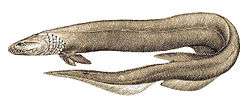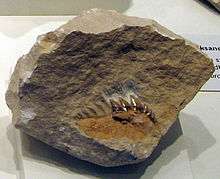Hexanchiformes
| Hexanchiformes Temporal range: Middle Jurassic–Recent Possible Paleozoic record | |
|---|---|
 | |
| Frilled shark, Chlamydoselachus anguineus | |
| Scientific classification | |
| Kingdom: | Animalia |
| Phylum: | Chordata |
| Class: | Chondrichthyes |
| Subclass: | Elasmobranchii |
| Superorder: | Selachimorpha |
| Order: | Hexanchiformes F. de Buen, 1926 |
| Families | |
|
†Crassonotidae | |
The Hexanchiformes are the order consisting of the most primitive types of sharks, and numbering just six extant species. Fossil sharks that were apparently very similar to modern sevengill species are known from Jurassic specimens.[2]
Hexanchiform sharks have only one dorsal fin, either six or seven gill slits, and no nictitating membrane in the eyes. Shark teeth similar to those modern hexanchids are known from Devonian deposits in Antarctica and Australia, as well as Permian deposits in Japan. If these are in fact hexanchids, this may be the only extant order of elasmobranchs to have survived after the Permian extinction (and by extension, the oldest extant order of elasmobranchs) .
The frilled shark, Chlamydoselachus anguineus, is very different from the cow sharks, and it has been proposed to be moved to its own order, Chlamydoselachiformes.
Classification
Living species
- Family Chlamydoselachidae Garman 1884 (frilled sharks)
- Chlamydoselachus Garman, 1884
- Chlamydoselachus africana Ebert & Compagno, 2009 (Southern African frilled shark)
- Chlamydoselachus anguineus Garman, 1884 (Frilled shark)
- Chlamydoselachus Garman, 1884
- Family Hexanchidae J. E. Gray 1851 (Cow sharks)
- Heptranchias Rafinesque, 1810
- Heptranchias perlo (Bonnaterre, 1788) (sharpnose sevengill shark)
- Hexanchus Rafinesque, 1810
- Hexanchus griseus (Bonnaterre, 1788) (bluntnose sixgill shark)
- Hexanchus nakamurai Teng, 1962 (bigeyed sixgill shark)
- Notorynchus Ayres, 1855
- Notorynchus cepedianus (Péron, 1807) (broadnose sevengill shark)
- Heptranchias Rafinesque, 1810
Extinct species

- Family Chlamydoselachidae
- Chlamydoselachus Garman, 1884
- Chlamydoselachus bracheri Pfeil, 1983
- Chlamydoselachus fiedleri Pfeil, 1983
- Chlamydoselachus garmani Welton, 1983
- Chlamydoselachus goliath Antunes & Cappetta, 2002
- Chlamydoselachus gracilis Antunes & Cappetta, 2002
- Chlamydoselachus keyesi Mannering & Hiller, 2008
- Chlamydoselachus landinii Carrillo-Briceño, Aguilera & Rodriguez, 2014
- Chlamydoselachus lawleyi Davis, 1887
- Chlamydoselachus tatere Consoli, 2008
- Chlamydoselachus thomsoni Richter & Ward, 1990
- Chlamydoselachus tobleri Leriche, 1929
- Proteothrinax Pfeil, 1983
- Proteothrinax baumgartneri Pfeil, 1983
- Chlamydoselachus Garman, 1884
- Family Crassonotidae
- Crassodontidanus Kriwet & Klug, 2011
- Crassodontidanus serratus Fraas, 1855
- Crassodontidanus wiedenrothi Thies, 1983
- Notidanoides Maisey, 1986
- Notidanoides muensteri Agassiz, 1843
- Notidanus Cuvier, 1816
- Notidanus amalthei Oppel, 1854
- Notidanus atrox Ameghino, 1899
- Notidanus intermedius Wagner, 1862
- Notidanus nikitini Chabakov & Zonov, 1935
- Pachyhexanchus Cappetta, 1990
- Pachyhexanchus pockrandti Ward & Thies, 1987
- Crassodontidanus Kriwet & Klug, 2011
- Family Hexanchidae
- Gladioserratus Underwood, Goswami, Prasad, Verma & Flynn, 2011
- Gladioserratus aptiensis Pictet, 1864
- Gladioserratus dentatus Guinot, Cappetta & Adnet, 2014
- Gladioserratus magnus Underwood, Goswami, Prasad, Verma & Flynn, 2011
- Heptranchias Rafinesque, 1810
- Heptranchias ezoensis Applegate & Uyeno, 1968
- Heptranchias howellii Reed, 1946
- Heptranchias karagalensis Kozlov in Zhelezko & Kozlov, 1999
- Heptranchias tenuidens Leriche, 1938
- Hexanchus Rafinesque, 1810
- Hexanchus agassizi Cappetta, 1976
- Hexanchus andersoni Jordan, 1907
- Hexanchus casieri Kozlov, 1999
- Hexanchus collinsonae Ward, 1979
- Hexanchus gracilis Davis, 1887
- Hexanchus hookeri Ward, 1979
- Hexanchus microdon Agassiz, 1843
- Hexanchus tusbairicus Kozlov in Zhelezko & Kozlov, 1999
- Notidanodon Cappetta, 1975
- Notidanodon brotzeni Siverson, 1995
- Notidanodon dentatus Woodward, 1886
- Notidanodon lanceolatus Woodward, 1886
- Notidanodon loozi Vincent, 1876
- Notidanodon pectinatus Agassiz, 1843
- Notorynchus Ayres, 1855
- Pachyhexanchus Cappetta, 1990
- Pachyhexanchus pockrandti Ward & Thies, 1987
- Paraheptranchias Pfeil, 1981
- Paraheptranchias repens Probst, 1879
- Pseudonotidanus Underwood & Ward, 2004
- Pseudonotidanus semirugosus Underwood & Ward, 2004
- Welcommia Cappetta, 1990
- Welcommia bodeuri Cappetta, 1990
- Welcommia cappettai Klug & Kriwet, 2010
- Weltonia Ward, 1979
- Weltonia ancistrodon Arambourg, 1952
- Weltonia burnhamensis Ward, 1979
- Gladioserratus Underwood, Goswami, Prasad, Verma & Flynn, 2011
- Family Mcmurdodontidae ?
- Mcmurdodus White, 1968
- Mcmurdodus featherensis White, 1968
- Mcmurdodus whitei Turner, & Young, 1987
- Mcmurdodus White, 1968
- Family Orthacodontidae
- Occitanodus Guinot, Cappetta & Adnet, 2014
- Occitanodus sudrei Guinot, Cappetta & Adnet, 2014
- Orthacodus Woodward, 1889
- Orthacodus longidens Agassiz, 1843
- Sphenodus Agassiz, 1843
- Sphenodus alpinus Gümbel, 1861
- Sphenodus longidens Agassiz, 1843
- Sphenodus lundgreni Davis, 1890
- Sphenodus macer Quenstedt, 1852
- Sphenodus nitidus Wagner, 1862
- Sphenodus planus Agassiz, 1843
- Sphenodus rectidens Emmons, 1858
- Sphenodus robustidens Seguenza, 1900
- Sphenodus tithonius Gemmellaro, 1871
- Sphenodus virgai Gemmellaro, 1871
- Occitanodus Guinot, Cappetta & Adnet, 2014
Species
| Family | Image | Common name | Genera | Species | Description |
|---|---|---|---|---|---|
| Chlamydoselachidae |  |
Frilled sharks | 1 extant 1 extinct |
2 extant 12 extinct |
Frilled sharks contain only two extant species of deepsea creatures which are typically weakened in areas closer to the surface. The most widely known species still surviving is the frilled shark, known as a living fossil, along with the Southern African frilled shark, found along coastal areas of South Africa. Several extinct species are known. |
| †Crassonotidae | †Crassonotidae | 4 | 8 | Extinct | |
| Hexanchidae | |
Cow sharks | 3 extant 5 extinct |
4 extant 31 extinct |
Cow sharks are considered the most primitive of all the sharks, because their skeletons resemble those of ancient extinct forms, with few modern adaptations. Their excretory and digestive systems are also unspecialised, suggesting that they may resemble those of primitive shark ancestors. Their most distinctive feature, however, is the presence of a sixth, and, in two genera, a seventh, gill slit, in addition to the five found in all other sharks.[3] They range from 1.4 metres (4.6 ft) to over 5.5 metres (18 ft) in adult body length. |
| †Mcmurdodontidae | †Mcmurdodontidae | 1 | 2 | Extinct | |
| †Orthacodontidae | †Orthacodontidae | 3 | 12 | Extinct |
See also
References
- Froese, Rainer, and Daniel Pauly, eds. (2011). "Chlamydoselachidae" in FishBase. February 2011 version. (Fish Base family reference)
- Froese, Rainer, and Daniel Pauly, eds. (2011). "Hexanchidae" in FishBase. February 2011 version. (Fish Base family reference)
- Allen, Thomas B. (1999). The Shark Almanac. New York: The Lyons Press. ISBN 1-55821-582-4.